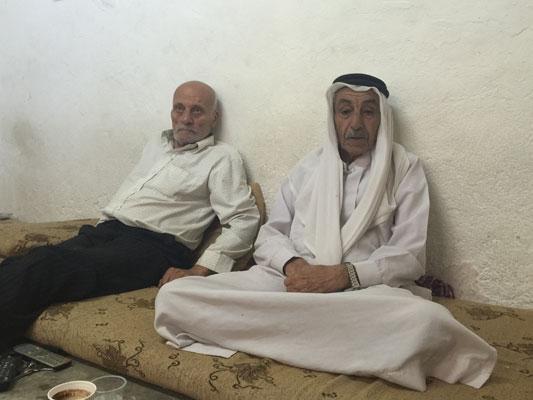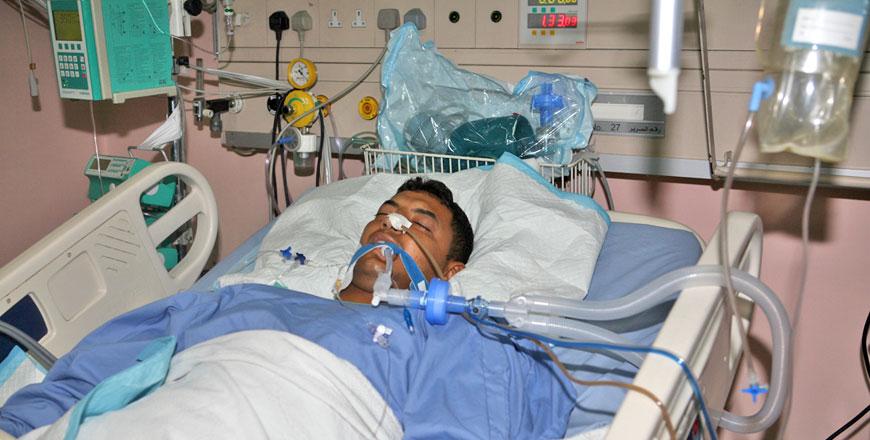You are here
50 years on, Shuneh residents still cherish memories of Jericho
By Dana Al Emam - Aug 10,2016 - Last updated at Aug 10,2016

Bishara Zoumot (left) and Daoud Adwan speak to The Jordan Times in a recent interview in their hometown of Shuneh in the Jordan Valley (Photo by Dana Al Emam)
SOUTHERN SHUNEH — Bishara Zoumot and Daoud Adwan still cherish their memories of Jericho, a city they haven’t visited for nearly 50 years.
For Zoumot, 80, and Adwan, 77, from Shuneh in the Jordan Valley, had regular visits to Jericho in their youth that contributed to the formation of their personalities as teenagers, and the city is just as dear to them half-a-century later.
Zoumot was around 18 years old when he started making frequent trips to Jericho, only 16 kilometres away from his home in Southern Shuneh, around 40km to the west of Amman.
“It was very fortunate for a young man like me at the time to collect JD2…. We would go to Jericho for lunch, coffee and evening entertainment,” Zoumot, who worked at a bakery, told The Jordan Times in a recent interview.
He would take the bus from Shuneh to Jericho, where the driver would normally exempt him from paying the two-piaster fare as he was young and did not appear well established.
People there were “very generous and humble”, he recalled, adding that families used to cook and invite random passersby to eat.
“I miss the food, the water, the weather and the fruits of Jericho…. Whenever anybody from Shuneh needed medical care, they would go to a hospital in Jericho,” he said.
Adwan took a different route to Jericho, to enjoy the beauty of the journey.
“I was only 17 when I would bike from Shuneh to Jericho through the King Abdullah Bridge, even though I lived near the King Hussein Bridge which would have taken me directly there,” he said, noting that he took the longer route to enjoy an hour-long ride.
On the other side, Adwan would pass through Aqbat Jaber Refugee Camp before reaching Jericho.
Built in 1957, the King Abdullah Bridge was destroyed during the 1967 war, leaving only the King Hussein Bridge, also called the Allenby Bridge after British Field Marshal Edmund Allenby, as the only route.
“Jericho was our city; we did not know Amman…. Jericho was five minutes away by taxi and everything we wanted was available there,” he told The Jordan Times.
Shuneh residents headed to Jericho to buy fruits and vegetables, clothes and food, he added.
Adwan, a farmer, said that fruits in Jericho were “phenomenal” because it was watered by the famous Ein Al Sultana Spring, recalling the city’s oranges, bananas and pomegranates.
The Jericho Municipality would spray streets with water to cool down the temperatures and clear the dust, Adwan recalled, noting that it was very refreshing to pass time in the city’s public parks.
The last time the two men visited Jericho was in 1967, when the city fell under Israeli occupation.
“A disaster fell on us when Jericho was occupied,” said Adwan.
Zoumot agreed. “I did not eat for two days,” he added.
But a new initiative dubbed “Jiran” (neighbours) seeks to build bridges of communication between the municipalities of Central Shuneh and Jericho, so that people like Zoumot and Adwan can relive some of their long-treasured memories.
Mohammad Atiyeh, the founder of Jiran, said the initiative aims to re-establish historical connections through local delegations, the exchange of knowledge and technical collaboration between the two areas, which are only separated by a shallow river, now constituting a border between Jordan and the Israeli-occupied Palestine.
“The initiative was inspired by a recent visit to Jericho from Shuneh… I hear a lot from men my age or older who have not seen Jericho since 1967, and used to visit, work, live and study there,” he said.
Born and raised in Jericho before it was occupied by Israel, and now a resident of Shuneh, Atiyeh feels a need to make borders “more humane” and to facilitate the movement of ideas and expertise between the two sides.
“There are many possible areas for collaboration, including in environmental, agricultural and tourism sectors,” he said.
Central Shuneh District Governor Ibrahim Adwan highlighted that the two areas shared a common history and geography, adding that the people of Shuneh and Jericho were one and had collectively suffered from the political repercussions of wars.
As a result of the 1967 Israeli occupation of Jericho, which was then part of Jordan, many residents of Jericho suburbs moved to live in Shuneh and blended with the community, he told The Jordan Times.
The governor said the two municipal councils are to meet in the near future to discuss means of cooperation, citing palm planting, waste management and administration as possible fields for exchanging expertise.
The ancient city of Jericho, known historically as Tal Al Sultan, is the lowest and oldest town on the Earth.
Archaeological excavations exposed 23 layers of ancient civilisations, and the oldest remains date back to the Natufian Period according to UNESCO’s website.
Zoumot and Adwan cling to hopes of being able to visit Jericho again, before it is too late.
“I dream about visiting Jericho again,” Adwan said.
“I will kiss Jericho’s soil if I ever put feet on its ground again,” said Zoumot.
Related Articles
AMMAN — Former minister of state Sultan Adwan on Saturday died at one of Amman’s hospitals, the Jordan News Agency, Petra, reported. H
AMMAN – Prime Minister Hani Mulki on Tuesday visited Sergeant Ahmad Adwan, who was injured when he assisted in the capture of a suspect in t
One man died and 10 other people from the same family were injured on Tuesday when their vehicle overturned in Northern Shuneh, according to the Civil Defence Department (CDD).

















